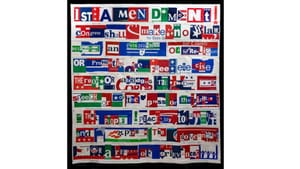Stay in the Loop
BSR publishes on a weekly schedule, with an email newsletter every Wednesday and Thursday morning. There’s no paywall, and subscribing is always free.
Using their words
The National Liberty Museum presents Word Powered

It’s a wild time in our nation’s history to declare this a “Year of Free Speech.” But that was the stated goal, long ago and far away in September 2024, when the National Liberty Museum (NLM) opened Free Speech: Our Right, Our Responsibility, the first of three exhibitions on the subject. This month, the site opened its second: Word Powered: Exploring Free Speech Through Art, a juried selection of 15 artists taking on the topic through multiple mediums.
So, first, a reminder. The First Amendment to the US Constitution says, “Congress shall make no law respecting an establishment of religion, or prohibiting the free exercise thereof; or abridging the freedom of speech, or of the press; or the right of the people peaceably to assemble, and to petition the Government for a redress of grievances.” The 14th Amendment ensures that state legislatures are also subject to these and all other constitutional requirements.
Melting pot or civil war?
All works in Word Powered were created between 2018 and 2024, which means every artist was aware of the rise in disinformation that accompanied the 2016 election, the Charlottesville, Virginia, “Unite the Right” rally, and Elon Musk’s claim of “free speech absolutism” in the wake of his Twitter purchase, to name a few relevant touchpoints. And it’s fitting that the first piece in the show, and one used in the museum’s advertising, is Shelley Brenner Baird’s 1st Amendment.
The piece, a boldly colored oversized square, spells out that amendment in letters cut from political campaign signs. Perhaps your neighborhood, like mine, erupted into a mini civil war during the most recent election, with signs going missing, neighbors outdoing each other with humongous flags, increasingly aggressive messages, and sheer masses of signage in various sizes.
Baird’s piece, rather than triggering an anxiety response, hangs as a reminder of the history and importance of political campaigning. Those signs weren’t supposed to be tribal signifiers, they were supposed to indicate political preference without fear of government retribution; they weren’t supposed to trigger a civil war, they were supposed to unite us in our shared civil rights and responsibilities. The ransom-note-style lettering indicates both a fractured landscape and happy jumble—is Baird referring to a melting pot or a hopelessly divided citizenry? Maybe both.
A mendacious mélange
Farther along hangs a different kind of mélange: Cassandra Zampini’s Media Warfare. A video mosaic featuring multiple simultaneous clips of YouTube conspirators, Zampini’s piece features all of 2020’s greatest disinformation hits and then some: Plandemic, adrenochrome, 9/11 truther-ism. The din is at once funny and horrifying. The choices never end, and not one stream has its roots in reality. This is free speech, all right; what do we think of the power in these words?
I happen to believe all speech isn’t equal, and simply airing these videos online unquestioned, at this point, is a whole lot like yelling “Fire!” in a crowded theater. And yet. Hanging them together in a museum gives them a formal context that feels just a little bit like fighting back. Of course, the viewer numbers in NLM’s small gallery won’t rival those of Alex Jones, but these days, we take our wins where we can.
When words speak volumes
Another work, by Dutch multidisciplinary artist (and former public defender) Marcia Haffmans, depicts the inverse of free speech with her installation The Weight of Words. It’s a clothesline hung with cobalt blue notepad-sized sheets of silk organza. On each sheet is a handwritten letter, printed in the negative by light-sensitive cyanotype processing. The sheets are sewn to the line, but because they’re so tightly packed, it’s nearly impossible to read most of them. They’re a visual representation of the millions of incarcerated voices we don’t hear in public, First Amendment notwithstanding.

Works like these earn a deeper examination, but not all do. For example, Merrill Smith Jr.’s O**ensive Stu**, featuring that line bordered by stripes reminiscent of police tape, hits its one note and stays there. The exhibition also includes works with an international angle (Iran, China). Title cards even carry accompanying questions, all intending to foster thoughtful discussion. (Who would like to answer this one: “How does the president affect your daily life?”)
It’s a compelling show, and could easily have gone twice as large. The subject and timing certainly warrant it. However, there’s not enough background on the works to give them their full heft, which they deserve. I’m assuming via a few clues that Haffmans’s letters were written by incarcerated women, but there’s no available description of her process or purpose. Sure, some of the works speak for themselves, but the best curators know how to deepen the experience while leaving room for interpretation and analysis. After all, as Word Powered shows, a few well-chosen words speak volumes.
What, When, Where
Word Powered: Exploring Free Speech Through Art. Through September 7, 2025, at the National Liberty Museum, 321 Chestnut Street, Philadelphia. (215) 925-2900 or libertymuseum.org.
Accessibility
The National Liberty Museum is a wheelchair-accessible building. Contact the museum by phone at (215) 925-2900 or by email for assistance or to arrange appropriate accommodation.
Sign up for our newsletter
All of the week's new articles, all in one place. Sign up for the free weekly BSR newsletters, and don't miss a conversation.

 Wendy Rosenfield
Wendy Rosenfield